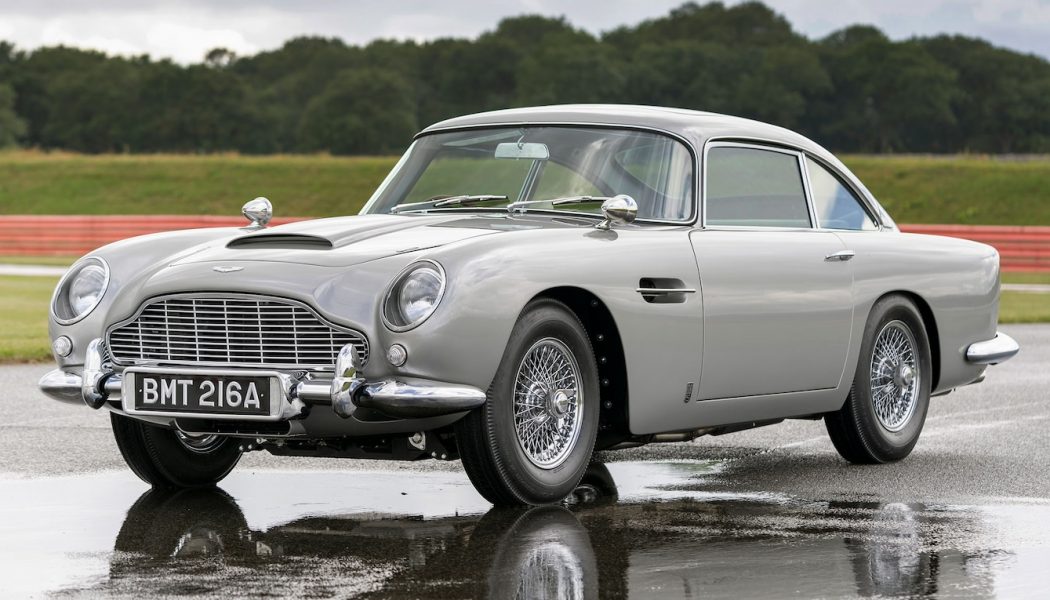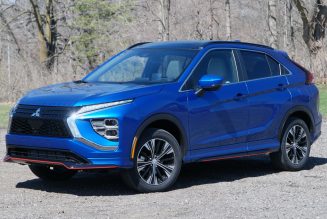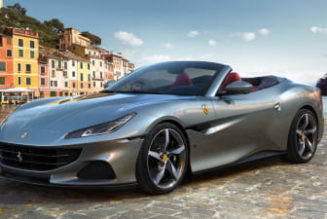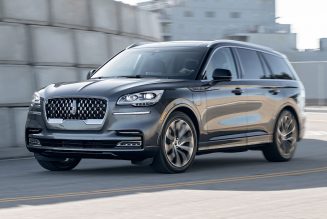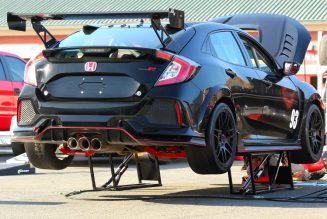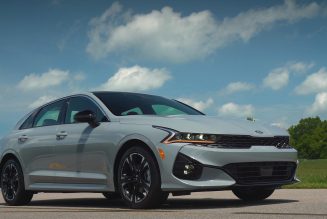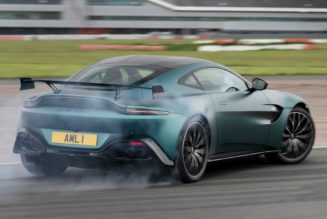The best thing about driving the Aston Martin DB5 Goldfinger Continuation? No, it’s not just playing with the gadgets—the revolving license plates, the machine guns, the bulletproof shield, and the rest of the 007 arsenal. It’s the fact that you’re driving a genuine 1964 Aston Martin DB5 that’s brand new from its Avon cross-ply tires up.
OK, the machine guns don’t fire real ammo, it sprays water out the rear rather than oil, and you can’t get rid of a tiresome passenger with an ejector seat. But the Goldfinger Continuation is still the real deal. It’s a real Aston Martin, built in the same shop in Newport Pagnell, England, where fewer than 900 DB5s were built between 1963 and 1965, with components manufactured using original drawings and digital data taken from original DB5 bodies and engines.
Sliding behind the wheel of the DB5 Goldfinger Continuation and firing up the 4.0-liter inline-six under the hood is like tumbling down a wormhole in the space-time continuum. You half expect to hear a Beatles tune crackling on the radio as you muscle the shifter into first gear, taking care, of course, not to lift the flap on the knob and accidentally thumb the red button hidden underneath.
The DB5 swaggered on the screen in the 1964 James Bond classic Goldfinger. Like almost all movie stars, however, it’s much smaller in real life. You can reach across the (right-hand-drive) cabin of the Goldfinger Continuation and touch the passenger door with the fingertips of your left hand. Six-footers will find their heads close to the roof lining. But while the spindly shifter and thin-rimmed steering wheel look delicate compared with the chunky items that adorn many of today’s performance cars, they flatter to deceive. As we’re about to discover, an Aston Martin DB5 is, in every sense, a muscular drive.
The DB5 Goldfinger Continuation is the brainchild of Aston Martin Works president Paul Spires, who has already overseen the production of DB4 GT and DB4 GT Zagato continuation cars at the operation’s Newport Pagnell facility, which also offers restoration and refurbishment services on all Aston Martin models.
For Spires, the Goldfinger Continuation project was a no-brainer. “It is the most famous car in the world, and it gave us a fantastic opportunity to showcase the artisan skills that we have on site.” But it also had to make money. “The business case discussions around continuation cars started a long time ago. Unlike the heritage operations of a lot of other manufacturers, this place has to be commercially viable. We don’t do these cars just because we want to.” Only 25 Goldfinger Continuation cars will be built. And each is priced at about $3.3 million at current exchange rates. Plus tax.
Creating a brand-new Aston Martin DB5 was a relatively straightforward task, made easier by technologies even 007’s gadget guru, Q, could have scarcely imagined 56 years ago. The bodies of several original DB5s were digitally scanned, and the data was reworked by Aston Martin design chief Marek Reichman’s team to ensure the surfaces were all true and both sides of the body were symmetrical. A number of original DB5 chassis were also scanned, and the data was overlayed with the 500 original drawings still in the Aston Martin archive to ensure accuracy.
An original DB5 engine was put through a high-powered CT scanner and, using a program especially written by Siemens, sliced digitally into 1-millimeter slivers so a set of new casting molds could be created. The process allowed engineers to correct an endemic overheating problem in the Tadek Marek-designed straight-six, not by redesigning the engine, but by making sure the cylinder head was cast the way it was originally intended. Spires says back in the ’60s the cooling core that runs down the middle of the head tended to shift slightly to one side when molten aluminum was poured into the mold. “The number-six piston always runs hot,” he says of old DB5 engines, “so we trued up the core to make sure we got better cooling.”
Suppliers also reached into their back catalog: Using documents from their archive, ZF’s heritage department (who knew?) built brand-new five-speed manual transmissions to exactly the same specification as used in the original DB5s, right down to the gear ratios. The brakes are to the exact same specification as the original car’s four-disc Girling setup, as are the telescopic front shocks and old-school lever action units on the rear axle with its mechanical limited-slip differential. At Spires’ request, British tiremaker Avon even made a fresh batch of cross-ply tires to the exact specification used on DB5s in 1964.
The decision to fit the DB5 Goldfinger with tires of period-correct construction raised eyebrows among the Aston Martin chassis development drivers, many of whom had never driven a car on old-school cross-ply rubber and struggled with the lack of grip and precision. But Spires was adamant the DB5 Goldfinger Continuation not only had to look exactly like it did in 1964; it had to drive exactly as it did in 1964.
“It’s supposed to slide and glide,” Spires says. “It’s how the car was back in 1964. We wanted that authentic feel.” He acknowledges radial tires would have given more grip and precision but insists they would also have fundamentally changed the entire car. “Radials put more load through the suspension, and therefore the car rolls more,” he says. “You start to slide out of the seats, the steering feels heavy. It’s easy then to start chasing your tail on chassis setup trying to fix it, and you end up with a car that isn’t authentic.”
Authentic. That’s absolutely the word to describe how the DB5 Goldfinger Continuation looks and feels and even smells on the road. Our car is one of two prototypes and has just over 800 miles on the odometer. There’s a whiff of gasoline from the triple SU carbs under the hood, mingling with the heavy aroma of diff oil. There’s a mechanical growl from the torquey 4.0-liter inline-six, which, even in fifth gear, pulls cleanly from as little as 1,000 rpm, roughly 25 mph. The clutch and brake pedals are hinged at the floor, the brake immediately adjacent to the organ-pedal throttle, which makes heel-and-toe downshifts a breeze.
The first few traffic circles on the route out of Newport Pagnell provide an opportunity to start reelin’ in the years. The gear shift is heavy and notchy and tight. In this low-mileage prototype you’re very aware you’re moving around bits of metal that are still getting to know each other, but road testers in the ’60s noted the ZF transmission required muscle and determination. Low-speed corners give you a complete upper-body workout as you muscle that skinny-rimmed steering wheel. Even ’60s road testers commented on the efforts required to steer the DB5 at low speeds, and reading between the lines, it’s clear they felt the car was much better suited to fast flowing roads and highways.
And 56 years later, nothing has changed.
On the highway the DB5 Goldfinger Continuation cruises effortlessly at 80 mph, the engine growling away happily at little more than 3,000 rpm. There’s a modicum of wind and other mechanical noise, of course, but by 1960s standards the DB5 was luxuriously refined. The most striking aspect of the car’s behavior, however, is the suppleness of the ride, a gentle compliance you simply don’t feel in any modern car, especially a modern GT.
Original factory numbers quoted the DB5 engine as producing 282 hp at 5,500 rpm and 280 lb-ft of torque at 4,500 rpm. Claimed top speed was 138 mph, though one British magazine recorded a measured 142.6 mph during a 1964 test, reporting also that the DB5 would accelerate from 0 to 60 mph in 8.1 seconds, and to 100 mph in under 20 seconds. It was stratospheric stuff in an era when Britain’s best-selling car, the Morris 1100, boasted a mere 46 hp and 60 lb-ft of torque, and was all done at just 78 mph.
Even today, on a winding two-lane with open corners, the DB5 feels fast. It’s not point-and-squirt quick—no ’60s GT car was—but it flows nicely down the road at a pace that in the days before sticky tires, massive brakes, and 500-hp engines would have seemed otherworldly. Third gear is brilliant on such roads, taking the Aston cleanly from 20 mph all the way to 80 mph. You learn to brake early for corners—pedal feel is good, and with four-wheel disc brakes on a car weighing a little over 3,200 pounds, the DB5 effortlessly washes off speed. Allow the Aston to settle, then turn in and allow it to work through all the compliance in the tires and the suspension. Once it’s taken a set, get on the gas, and power out the corner.
You can’t rush it. You don’t want to rush it. It’s all part of the authentic ’60s drive experience.
Sadly, not many of the 25 DB5 Goldfinger Continuation cars are likely to be driven very far, or very fast. It’s not just the multi-million-dollar price tag: Though they are genuine Aston Martins, they do not meet current emissions and crash regulations and cannot legally be sold as road-ready vehicles. “It’s built to a road specification, and should a customer want to drive it on their private land or a circuit, then obviously they can,” Spires says. “And there are certain places in the world, I think, where it might be easier to drive the car on the road. But it’s down to the customer. The customer buys from us. What they decide to do with it after that, is up to them.”
A total of four 007-spec DB5s were built in the 1960s, two of which appeared in the movie, and two of which were used for PR purposes. The original movie car—chassis number DP/216/1—actually started life as a DB4 before Aston Martin modified it to DB5 spec and used it for development testing. This well-used test mule was subsequently loaned to Eon Productions for the Goldfinger shoot in early 1964, where the film’s special effects team fitted all the Bond gadgetry.
All the movie magic stuff added 300 pounds to the car’s weight and restricted its mobility—fitting the 30-caliber Browning machine guns in the front fenders reduced the available steering angle to 5 degrees, for example—so a second, stock Silver Birch DB5 was supplied for the high-speed action sequences. This car was later retrofitted with all the Bond goodies.
Spires’ team worked closely with 007 movie franchise holder Eon Productions and Chris Corbould, who has overseen the special effects on the past 15 Bond films, to make the gadgets as authentically functional as possible, while ensuring the DB5 Goldfinger Continuation remained fully drivable. And this, Spires says, was more of a challenge than creating a brand-new Aston Martin DB5. “Trying to create gadgets from a 1960s film in 2020, ensuring the quality and the repeatability acceptable to our customers today, was incredibly hard to do. Did we underestimate it? Maybe… We thought it was going to be easier than it was.”
Hardest of the gadgets to engineer? “Probably the smoke machine,” Spires says. “Finding one that was small enough, heated up quickly enough, and that that gave us enough smoke, was hard.” The Aston Martin Works engineers fitted an additional blower and a stainless-steel nozzle underneath the car to ensure the smoke flowed in the right direction. “It gives you this fantastic smoke effect,” Spires says. “I think it’s actually even better than in the film.”
All the DB5 Goldfinger Continuation’s 007 arsenal is controlled—as in the movie car—via switches and levers in the center armrest. But those owners who wish to share their friends’ amusement can use a remote-control unit that allows them to stand outside the car and actuate all the gadgets. The only ones that don’t “work” are the ejector seat (for obvious reasons, though the roof panel can be removed) and the tire slashers that extend from the rear axles. “It just wasn’t possible to have axles and bearings strong enough to make it work,” Spires says. The fully extended tire slashers sit in a box in the trunk and can be fitted for static display.
The James Bond Aston Martin DB5 diecast model produced by Britain’s Corgi Toys in 1965 remains the single best-selling product in the company’s lineup. It’s been revised and updated over the past 55 years, but it’s still in production, and more than seven million have been sold. But to describe the Aston Martin DB5 Goldfinger Continuation as simply the very definition of a big boy’s toy is to sell it short. Underneath is a proper car that authentically, lovingly re-creates an automotive experience from a bygone era.
“You can certainly drive it as a DB5,” Spires says. “But when appropriate, you can put on your black tie and, just for a moment, be Sean Connery.”
